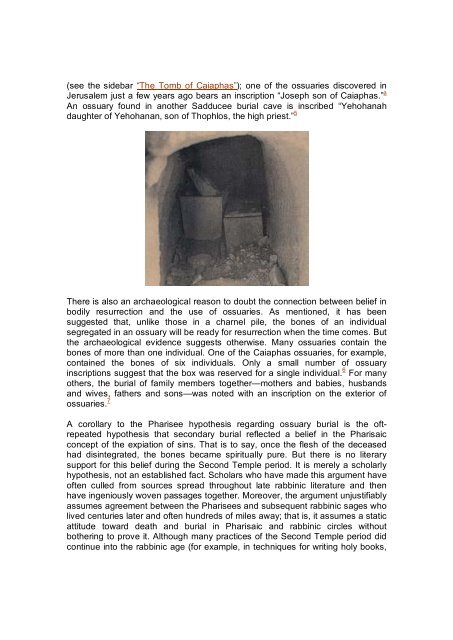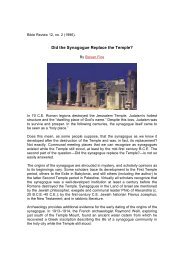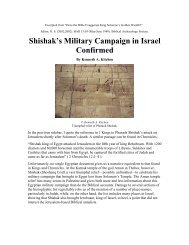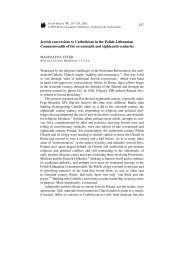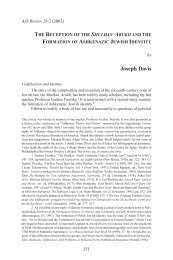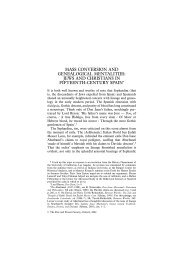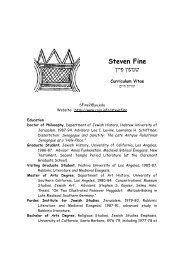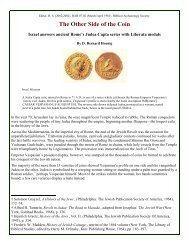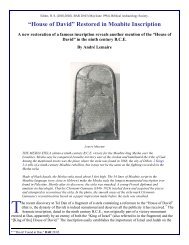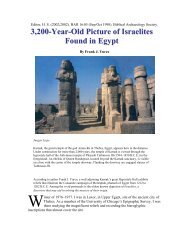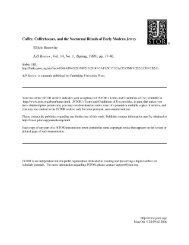Why Bone Boxes? Splendor of Herodian Jerusalem reflected in ...
Why Bone Boxes? Splendor of Herodian Jerusalem reflected in ...
Why Bone Boxes? Splendor of Herodian Jerusalem reflected in ...
You also want an ePaper? Increase the reach of your titles
YUMPU automatically turns print PDFs into web optimized ePapers that Google loves.
(see the sidebar “The Tomb <strong>of</strong> Caiaphas”); one <strong>of</strong> the ossuaries discovered <strong>in</strong><br />
<strong>Jerusalem</strong> just a few years ago bears an <strong>in</strong>scription “Joseph son <strong>of</strong> Caiaphas.” a<br />
An ossuary found <strong>in</strong> another Sadducee burial cave is <strong>in</strong>scribed “Yehohanah<br />
daughter <strong>of</strong> Yehohanan, son <strong>of</strong> Thophlos, the high priest.” 5<br />
There is also an archaeological reason to doubt the connection between belief <strong>in</strong><br />
bodily resurrection and the use <strong>of</strong> ossuaries. As mentioned, it has been<br />
suggested that, unlike those <strong>in</strong> a charnel pile, the bones <strong>of</strong> an <strong>in</strong>dividual<br />
segregated <strong>in</strong> an ossuary will be ready for resurrection when the time comes. But<br />
the archaeological evidence suggests otherwise. Many ossuaries conta<strong>in</strong> the<br />
bones <strong>of</strong> more than one <strong>in</strong>dividual. One <strong>of</strong> the Caiaphas ossuaries, for example,<br />
conta<strong>in</strong>ed the bones <strong>of</strong> six <strong>in</strong>dividuals. Only a small number <strong>of</strong> ossuary<br />
<strong>in</strong>scriptions suggest that the box was reserved for a s<strong>in</strong>gle <strong>in</strong>dividual. 6 For many<br />
others, the burial <strong>of</strong> family members together—mothers and babies, husbands<br />
and wives, fathers and sons—was noted with an <strong>in</strong>scription on the exterior <strong>of</strong><br />
ossuaries. 7<br />
A corollary to the Pharisee hypothesis regard<strong>in</strong>g ossuary burial is the <strong>of</strong>t<br />
repeated hypothesis that secondary burial <strong>reflected</strong> a belief <strong>in</strong> the Pharisaic<br />
concept <strong>of</strong> the expiation <strong>of</strong> s<strong>in</strong>s. That is to say, once the flesh <strong>of</strong> the deceased<br />
had dis<strong>in</strong>tegrated, the bones became spiritually pure. But there is no literary<br />
support for this belief dur<strong>in</strong>g the Second Temple period. It is merely a scholarly<br />
hypothesis, not an established fact. Scholars who have made this argument have<br />
<strong>of</strong>ten culled from sources spread throughout late rabb<strong>in</strong>ic literature and then<br />
have <strong>in</strong>geniously woven passages together. Moreover, the argument unjustifiably<br />
assumes agreement between the Pharisees and subsequent rabb<strong>in</strong>ic sages who<br />
lived centuries later and <strong>of</strong>ten hundreds <strong>of</strong> miles away; that is, it assumes a static<br />
attitude toward death and burial <strong>in</strong> Pharisaic and rabb<strong>in</strong>ic circles without<br />
bother<strong>in</strong>g to prove it. Although many practices <strong>of</strong> the Second Temple period did<br />
cont<strong>in</strong>ue <strong>in</strong>to the rabb<strong>in</strong>ic age (for example, <strong>in</strong> techniques for writ<strong>in</strong>g holy books,


